Overview
- Brief Narrative
- Unused Waffen SS single stripe chevron sleeve patch acquired by 22 year old Lt. Charles Rudulph, United States Army, during a July 10, 1945, visit to the former Dachau concentration camp near Munich in Germany. The badge would have been worn on the left, upper sleeve below the Reichsadler national emblem on the tunic of an SS-Sturmmann [Lance-Corporal. The SS (Schutzstaffel; Protection Squadrons) established Dachau, the first concentration camp in Nazi Germany, in March 1933. The SS commanded, administered, and guarded all concentration camps, and were known for their cruelty. Dachau was liberated by American forces on April 29, 1945. Rudulph, an officer in the 106th Infantry, entered combat in France in November 1944. He was wounded during the Battle of the Bulge but rejoined his unit. After Germany surrendered on May 7, he was posted to Straubing with Battery X, 566th AAA Battalion.
- Date
-
found:
1945 July 10
- Geography
-
found:
Dachau (Concentration camp) after liberation;
Dachau (Germany)
- Credit Line
- United States Holocaust Memorial Museum Collection, Gift of Ramona A. Rudulph
- Contributor
-
Subject:
Charles C. Rudulph
- Biography
-
Charles Clinton Rudulph Jr. was born on March 24, 1923, in Cleveland, Ohio, to Charles Clinton and Catharine Jacobs Rudulph. His family moved to Wilmington, Delaware, where he graduated from P.S. DuPont High School. Charles was attending Beacom College when he enlisted in the US Army in July 1941. He joined the Coast Artillery Corps or Army Mine Planter Service, Panama Canal Department. On December 7, 1941, Japan bombed Pearl Harbor and, a few days later, the US declared war on Japan and Germany. After a year and a half, Charles returned from the Panama Canal Dept. to attend officer training school in Fort Benning, Georgia.
Lieutenant Rudulph was assigned to the 106th Infantry Division, which was activated in March 1943. The division deployed to the European Theater of Operations in November 1944, landing in Le Havre, France. In December, they were in St. Vith, Belgium, to relieve the 2nd Infantry on the rugged, hilly border with Germany. Charles was wounded in the early days of the Battle of the Bulge and sent to England to recover. Most of the 106th were captured by the Germans. It is not known when Charles rejoined the division. In February 1945, the 106th crossed into Germany, then back into France where they processed German prisoners of war. The division was regrouping near Mayen, Germany, when the war ended with the German surrender on May 7. For his service in the postwar military occupation, Charles was stationed in Straubing, Germany, with Battery X, 566th AAA Aw Bn (Anti-aircraft, automatic weapons battalion.) During this time, he made two visits to Dachau concentration camp near Munich. During his first visit, he toured the camp with a former inmate, a German who had been a prisoner there for four years. They viewed the crematorium and storage areas, and Charles became ill seven times during the visit. His second visit was July 15, 1945, and he served as guide for a group of other soldiers.
After his return to the US, Charles enrolled in the University of Delaware. On September 18, 1946, he married Irene Hazel West, from Bournemouth, England, whom he had met while recuperating from his wounds. They had two children. He and Hazel divorced in December 1974. The same month, Charles married Ramona Boudreau White. Charles, 79, died in December 2002 in Clarkdale, Arizona.
Physical Details
- Classification
-
Military Insignia
- Category
-
Badges
- Object Type
-
Chevrons (lcsh)
- Genre/Form
- Emblems
- Physical Description
- Unused black wool inverted triangular patch with 1 downward pointing V, or chevron, formed from 2 narrow bars of diamond patterned cloth sewn along the sides and meeting at the apex.
- Dimensions
- overall: Height: 2.875 inches (7.302 cm) | Width: 3.125 inches (7.938 cm)
- Materials
- overall : wool, thread
Rights & Restrictions
- Conditions on Access
- No restrictions on access
- Conditions on Use
- No restrictions on use
Keywords & Subjects
- Topical Term
- Soldiers--United States--Biography. World War, 1939-1945--Personal narratives, American.
- Geographic Name
- Germany--History--1945-1955.
Administrative Notes
- Legal Status
- Permanent Collection
- Provenance
- The badge was donated to the United States Holocaust Memorial Museum in 2003 by Ramona A. Rudulph, the wife of Charles Rudulph.
- Funding Note
- The cataloging of this artifact has been supported by a grant from the Conference on Jewish Material Claims Against Germany.
- Record last modified:
- 2024-05-06 14:34:29
- This page:
- https://collections.ushmm.org/search/catalog/irn46057
Download & Licensing
In-Person Research
- By Appointment
- Request 21 Days in Advance of Visit
- Plan a Research Visit
- Request to See This Object
Contact Us
Also in Charles Rudulph collection
The collection consists of sixteen SS patches, two crematorium tags, correspondence, documents, and photographs relating to the experiences of Lt. Charles Rudulph, United States Army, in Germany after World War II.
Date: 1945 July

Unused Waffen SS sleeve chevron acquired postwar by a US soldier
Object
Unused Waffen SS single stripe chevron sleeve patch acquired by 22 year old Lt. Charles Rudulph, United States Army, during a July 10, 1945, visit to the former Dachau concentration camp near Munich in Germany. The badge would have been worn on the left, upper sleeve below the Reichsadler national emblem on the tunic of an SS-Sturmmann [Lance-Corporal. The SS (Schutzstaffel; Protection Squadrons) established Dachau, the first concentration camp in Nazi Germany, in March 1933. The SS commanded, administered, and guarded all concentration camps, and were known for their cruelty. Dachau was liberated by American forces on April 29, 1945. Rudulph, an officer in the 106th Infantry, entered combat in France in November 1944. He was wounded during the Battle of the Bulge but rejoined his unit. After Germany surrendered on May 7, he was posted to Straubing with Battery X, 566th AAA Battalion.

Unused Waffen SS sleeve chevron acquired postwar by a US soldier
Object
Unused Waffen SS single stripe chevron sleeve patch acquired by 22 year old Lt. Charles Rudulph, United States Army, during a July 10, 1945, visit to the former Dachau concentration camp near Munich in Germany. The badge would have been worn on the left, upper sleeve below the Reichsadler national emblem on the tunic of an SS-Sturmmann [Lance-Corporal. The SS (Schutzstaffel; Protection Squadrons) established Dachau, the first concentration camp in Nazi Germany, in March 1933. The SS commanded, administered, and guarded all concentration camps, and were known for their cruelty. Dachau was liberated by American forces on April 29, 1945. Rudulph, an officer in the 106th Infantry, entered combat in France in November 1944. He was wounded during the Battle of the Bulge but rejoined his unit. After Germany surrendered on May 7, he was posted to Straubing with Battery X, 566th AAA Battalion.
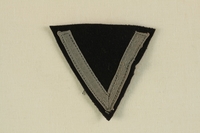
Unused Waffen SS sleeve chevron acquired postwar by a US soldier
Object
Unused Waffen SS single stripe chevron sleeve patch acquired by 22 year old Lt. Charles Rudulph, United States Army, during a July 10, 1945, visit to the former Dachau concentration camp near Munich in Germany. The badge would have been worn on the left, upper sleeve below the Reichsadler national emblem on the tunic of an SS-Sturmmann [Lance-Corporal. The SS (Schutzstaffel; Protection Squadrons) established Dachau, the first concentration camp in Nazi Germany, in March 1933. The SS commanded, administered, and guarded all concentration camps, and were known for their cruelty. Dachau was liberated by American forces on April 29, 1945. Rudulph, an officer in the 106th Infantry, entered combat in France in November 1944. He was wounded during the Battle of the Bulge but rejoined his unit. After Germany surrendered on May 7, he was posted to Straubing with Battery X, 566th AAA Battalion.

Unused Waffen SS sleeve chevron acquired postwar by a US soldier
Object
Unused Waffen SS single stripe chevron sleeve patch acquired by 22 year old Lt. Charles Rudulph, United States Army, during a July 10, 1945, visit to the former Dachau concentration camp near Munich in Germany. The badge would have been worn on the left, upper sleeve below the Reichsadler national emblem on the tunic of an SS-Sturmmann [Lance-Corporal. The SS (Schutzstaffel; Protection Squadrons) established Dachau, the first concentration camp in Nazi Germany, in March 1933. The SS commanded, administered, and guarded all concentration camps, and were known for their cruelty. Dachau was liberated by American forces on April 29, 1945. Rudulph, an officer in the 106th Infantry, entered combat in France in November 1944. He was wounded during the Battle of the Bulge but rejoined his unit. After Germany surrendered on May 7, he was posted to Straubing with Battery X, 566th AAA Battalion.
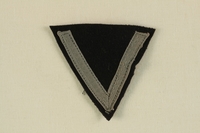
Unused Waffen SS sleeve chevron acquired postwar by a US soldier
Object
Unused Waffen SS single stripe chevron sleeve patch acquired by 22 year old Lt. Charles Rudulph, United States Army, during a July 10, 1945, visit to the former Dachau concentration camp near Munich in Germany. The badge would have been worn on the left, upper sleeve below the Reichsadler national emblem on the tunic of an SS-Sturmmann [Lance-Corporal. The SS (Schutzstaffel; Protection Squadrons) established Dachau, the first concentration camp in Nazi Germany, in March 1933. The SS commanded, administered, and guarded all concentration camps, and were known for their cruelty. Dachau was liberated by American forces on April 29, 1945. Rudulph, an officer in the 106th Infantry, entered combat in France in November 1944. He was wounded during the Battle of the Bulge but rejoined his unit. After Germany surrendered on May 7, he was posted to Straubing with Battery X, 566th AAA Battalion.

Unused Waffen SS sleeve chevron acquired postwar by a US soldier
Object
Unused Waffen SS single stripe chevron sleeve patch acquired by 22 year old Lt. Charles Rudulph, United States Army, during a July 10, 1945, visit to the former Dachau concentration camp near Munich in Germany. The badge would have been worn on the left, upper sleeve below the Reichsadler national emblem on the tunic of an SS-Sturmmann [Lance-Corporal. The SS (Schutzstaffel; Protection Squadrons) established Dachau, the first concentration camp in Nazi Germany, in March 1933. The SS commanded, administered, and guarded all concentration camps, and were known for their cruelty. Dachau was liberated by American forces on April 29, 1945. Rudulph, an officer in the 106th Infantry, entered combat in France in November 1944. He was wounded during the Battle of the Bulge but rejoined his unit. After Germany surrendered on May 7, he was posted to Straubing with Battery X, 566th AAA Battalion.
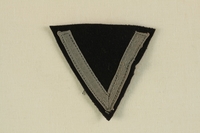
Unused Waffen SS sleeve chevron acquired postwar by a US soldier
Object
Unused Waffen SS single stripe chevron sleeve patch acquired by 22 year old Lt. Charles Rudulph, United States Army, during a July 10, 1945, visit to the former Dachau concentration camp near Munich in Germany. The badge would have been worn on the left, upper sleeve below the Reichsadler national emblem on the tunic of an SS-Sturmmann [Lance-Corporal. The SS (Schutzstaffel; Protection Squadrons) established Dachau, the first concentration camp in Nazi Germany, in March 1933. The SS commanded, administered, and guarded all concentration camps, and were known for their cruelty. Dachau was liberated by American forces on April 29, 1945. Rudulph, an officer in the 106th Infantry, entered combat in France in November 1944. He was wounded during the Battle of the Bulge but rejoined his unit. After Germany surrendered on May 7, he was posted to Straubing with Battery X, 566th AAA Battalion.
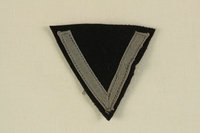
Unused Waffen SS sleeve chevron acquired postwar by a US soldier
Object
Unused Waffen SS single stripe chevron sleeve patch acquired by 22 year old Lt. Charles Rudulph, United States Army, during a July 10, 1945, visit to the former Dachau concentration camp near Munich in Germany. The badge would have been worn on the left, upper sleeve below the Reichsadler national emblem on the tunic of an SS-Sturmmann [Lance-Corporal. The SS (Schutzstaffel; Protection Squadrons) established Dachau, the first concentration camp in Nazi Germany, in March 1933. The SS commanded, administered, and guarded all concentration camps, and were known for their cruelty. Dachau was liberated by American forces on April 29, 1945. Rudulph, an officer in the 106th Infantry, entered combat in France in November 1944. He was wounded during the Battle of the Bulge but rejoined his unit. After Germany surrendered on May 7, he was posted to Straubing with Battery X, 566th AAA Battalion.
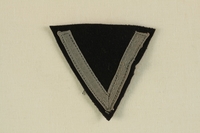
Unused Waffen SS sleeve chevron acquired postwar by a US soldier
Object
Unused Waffen SS single stripe chevron sleeve patch acquired by 22 year old Lt. Charles Rudulph, United States Army, during a July 10, 1945, visit to the former Dachau concentration camp near Munich in Germany. The badge would have been worn on the left, upper sleeve below the Reichsadler national emblem on the tunic of an SS-Sturmmann [Lance-Corporal. The SS (Schutzstaffel; Protection Squadrons) established Dachau, the first concentration camp in Nazi Germany, in March 1933. The SS commanded, administered, and guarded all concentration camps, and were known for their cruelty. Dachau was liberated by American forces on April 29, 1945. Rudulph, an officer in the 106th Infantry, entered combat in France in November 1944. He was wounded during the Battle of the Bulge but rejoined his unit. After Germany surrendered on May 7, he was posted to Straubing with Battery X, 566th AAA Battalion.
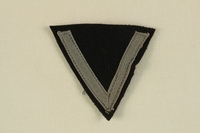
Unused Waffen SS sleeve chevron acquired postwar by a US soldier
Object
Unused Waffen SS single stripe chevron sleeve patch acquired by 22 year old Lt. Charles Rudulph, United States Army, during a July 10, 1945, visit to the former Dachau concentration camp near Munich in Germany. The badge would have been worn on the left, upper sleeve below the Reichsadler national emblem on the tunic of an SS-Sturmmann [Lance-Corporal. The SS (Schutzstaffel; Protection Squadrons) established Dachau, the first concentration camp in Nazi Germany, in March 1933. The SS commanded, administered, and guarded all concentration camps, and were known for their cruelty. Dachau was liberated by American forces on April 29, 1945. Rudulph, an officer in the 106th Infantry, entered combat in France in November 1944. He was wounded during the Battle of the Bulge but rejoined his unit. After Germany surrendered on May 7, he was posted to Straubing with Battery X, 566th AAA Battalion.

Unused Waffen SS sleeve chevron acquired postwar by a US soldier
Object
Unused Waffen SS single stripe chevron sleeve patch acquired by 22 year old Lt. Charles Rudulph, United States Army, during a July 10, 1945, visit to the former Dachau concentration camp near Munich in Germany. The badge would have been worn on the left, upper sleeve below the Reichsadler national emblem on the tunic of an SS-Sturmmann [Lance-Corporal. The SS (Schutzstaffel; Protection Squadrons) established Dachau, the first concentration camp in Nazi Germany, in March 1933. The SS commanded, administered, and guarded all concentration camps, and were known for their cruelty. Dachau was liberated by American forces on April 29, 1945. Rudulph, an officer in the 106th Infantry, entered combat in France in November 1944. He was wounded during the Battle of the Bulge but rejoined his unit. After Germany surrendered on May 7, he was posted to Straubing with Battery X, 566th AAA Battalion.
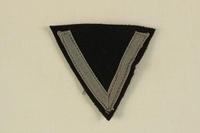
Unused Waffen SS sleeve chevron acquired postwar by a US soldier
Object
Unused Waffen SS single stripe chevron sleeve patch acquired by 22 year old Lt. Charles Rudulph, United States Army, during a July 10, 1945, visit to the former Dachau concentration camp near Munich in Germany. The badge would have been worn on the left, upper sleeve below the Reichsadler national emblem on the tunic of an SS-Sturmmann [Lance-Corporal. The SS (Schutzstaffel; Protection Squadrons) established Dachau, the first concentration camp in Nazi Germany, in March 1933. The SS commanded, administered, and guarded all concentration camps, and were known for their cruelty. Dachau was liberated by American forces on April 29, 1945. Rudulph, an officer in the 106th Infantry, entered combat in France in November 1944. He was wounded during the Battle of the Bulge but rejoined his unit. After Germany surrendered on May 7, he was posted to Straubing with Battery X, 566th AAA Battalion.
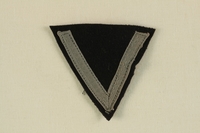
Unused Waffen SS sleeve chevron acquired postwar by a US soldier
Object
Unused Waffen SS single stripe chevron sleeve patch acquired by 22 year old Lt. Charles Rudulph, United States Army, during a July 10, 1945, visit to the former Dachau concentration camp near Munich in Germany. The badge would have been worn on the left, upper sleeve below the Reichsadler national emblem on the tunic of an SS-Sturmmann [Lance-Corporal. The SS (Schutzstaffel; Protection Squadrons) established Dachau, the first concentration camp in Nazi Germany, in March 1933. The SS commanded, administered, and guarded all concentration camps, and were known for their cruelty. Dachau was liberated by American forces on April 29, 1945. Rudulph, an officer in the 106th Infantry, entered combat in France in November 1944. He was wounded during the Battle of the Bulge but rejoined his unit. After Germany surrendered on May 7, he was posted to Straubing with Battery X, 566th AAA Battalion.
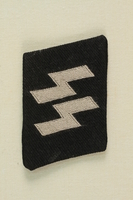
Unused Waffen-SS collar tab acquired postwar by a US soldier
Object
Unused Waffen SS collar tab with lightning bolt insignia acquired by 22 year old Lt. Charles Rudulph, United States Army, during a July 10, 1945, visit to the former Dachau concentration camp near Munich in Germany. The tab would have been worn in a pair on the collar points of a uniform shirt or jacket. The SS (Schutzstaffel; Protection Squadrons) established Dachau, the first concentration camp in Nazi Germany, in March 1933. The SS commanded, administered, and guarded all concentration camps, and were known for their cruelty. Dachau was liberated by American forces on April 29, 1945. Rudulph, an officer in the 106th Infantry, entered combat in France in November 1944. He was wounded during the Battle of the Bulge but rejoined his unit. After Germany surrendered on May 7, he was posted to Straubing with Battery X, 566th AAA Battalion.
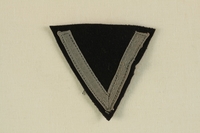
Unused Waffen SS sleeve chevron acquired postwar by a US soldier
Object
Unused Waffen SS single stripe chevron sleeve patch acquired by 22 year old Lt. Charles Rudulph, United States Army, during a July 10, 1945, visit to the former Dachau concentration camp near Munich in Germany. The badge would have been worn on the left, upper sleeve below the Reichsadler national emblem on the tunic of an SS-Sturmmann [Lance-Corporal. The SS (Schutzstaffel; Protection Squadrons) established Dachau, the first concentration camp in Nazi Germany, in March 1933. The SS commanded, administered, and guarded all concentration camps, and were known for their cruelty. Dachau was liberated by American forces on April 29, 1945. Rudulph, an officer in the 106th Infantry, entered combat in France in November 1944. He was wounded during the Battle of the Bulge but rejoined his unit. After Germany surrendered on May 7, he was posted to Straubing with Battery X, 566th AAA Battalion.

Crematorium tag, number 5896, acquired at Dachau postwar by a US soldier
Object
Unused clay crematorium disc with the number 5896 acquired by 22 year old Lt. Charles Rudulph, United States Army, during a July 10, 1945, tour of the crematorium of Dachau concentration camp near Munich in Germany. This type of disc was placed with a body to identify the ashes after cremation. The numbers do not correspond to prisoner numbers. Rudulph found it in what he called the murder house, with the cremation urns in a cellar between the room where bodies were stored and the ovens. Dachau was the first concentration camp established by the SS in March 1933, originally for political prisoners. Over time, other groups were interned there, including Jehovah's Witnesses, Roma, homosexuals, repeat criminal offenders, and Jews. The camp was liberated by American forces on April 29, 1945. Rudulph, an officer in the 106th Infantry, entered combat in France in November 1944. He was wounded during the Battle of the Bulge but rejoined his unit. After Germany surrendered on May 7, he was posted to Straubing with Battery X, 566th AAA Battalion.
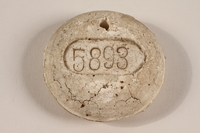
Crematorium tag, number 5893, acquired at Dachau postwar by a US soldier
Object
Unused clay crematorium disc with the number 5893 acquired by 22 year old Lt. Charles Rudulph, United States Army, during a July 10, 1945, tour of the crematorium at Dachau concentration camp near Munich, Germany. This type of disc was placed with a body to identify the ashes after cremation. The numbers do not correspond to prisoner numbers. Rudulph found it in what he called the murder house, with the cremation urns in a cellar between the room where bodies were stored and the ovens. Dachau was the first concentration camp established by the SS in March 1933, originally for political prisoners. Over time, other groups were interned there, including Jehovah's Witnesses, Roma, homosexuals, repeat criminal offenders, and Jews. The camp was liberated by American forces on April 29, 1945. Rudulph, an officer in the 106th Infantry, entered combat in France in November 1944. He was wounded during the Battle of the Bulge but rejoined his unit. After Germany surrendered on May 7, he was posted to Straubing with Battery X, 566th AAA Battalion.
Charles Rudolph papers
Document
Contains one letter, a visitors pass, six photographs, and two crematorium identification tags (Dachau).



